This wonderful Cornish workshop and museum is dedicated to the legacy of studio pottery trailblazer Bernard Leach
Become an instant expert on the history of Christmas cards
Become an instant expert on the history of Christmas cards
22 Dec 2020
The Christmas card is an art form of its own – but when was the first one sent, and who created it? We ask our expert, Arts Society Lecturer Dr Patricia Andrew
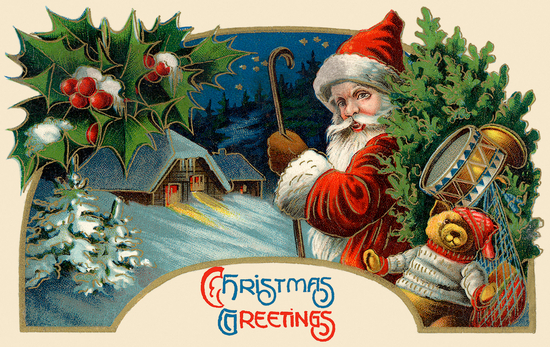 Father Christmas makes a delivery, c.1914
Father Christmas makes a delivery, c.1914
‘Just published. A Christmas Congratulation Card: or picture emblematical of Old English Festivity to Perpetuate kind recollections between Dear Friends’
An advertisement in The Athenaeum for a commercial phenomenon already part of everybody’s life
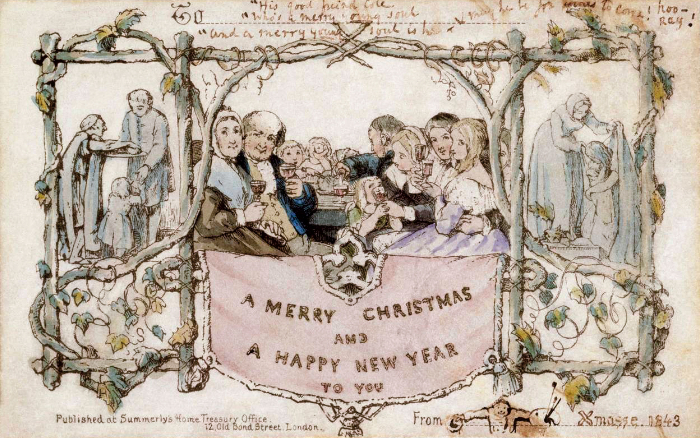
John Callcott Horsley’s 1843 card
1. THE VERY FIRST CHRISTMAS CARD
The origins of the Christmas card lie in New Year goodwill greetings, a global tradition for centuries, before Christmas greetings were ever thought of. This, above, is the first actual Christmas card. It was a British invention, in 1843, prompted by innovations such as the pre-manufactured envelope (replacing folded letters sealed with wax) and postage stamps.
Its inventor was the entrepreneur Henry Cole, who had been instrumental in establishing the (Uniform) Penny Post. He commissioned the artist John Callcott Horsley to design the card. It shows three generations of the Cole family enjoying their Christmas dinner and raising a toast to the card's recipient, with side scenes depicting charitable deeds, structured as a triptych.
Cole commissioned a printer to transfer Horsley’s design onto cards. A thousand copies were printed, which could then be personalised with a hand-written message. The hand-coloured cards cost a shilling each (a substantial sum at the time) and were considered a commercial failure. In addition, the image of a family drinking wine together – including one of the children being given a glass – drew criticism. This was, after all, an era when the temperance movement was gaining ground. Despite this, the concept of the card proved popular, enhanced by the success of Charles Dickens’ A Christmas Carol, which appeared the same year.
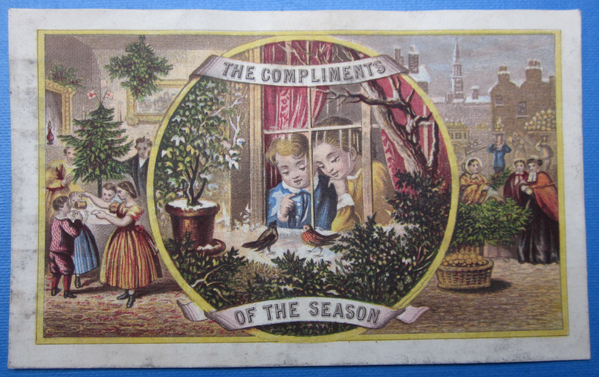
A colourful Victorian Christmas card
2. ANIMALS, SNOW SCENES, FAMILIES AND FOOD... BUT WHERE IS THE CHRISTMAS STORY?
The growing middle classes provided a ready market for these new festive cards. At first, the designs were simply adapted from other cards, with a change of wording. Many were originally Valentine cards, with punched ‘paper lace’ patterns, often in layers or arranged as a pop-up book, with a background of flowers or country scenes.
Once it was realised that Christmas cards were here to stay, the subjects changed and became more elaborate. There were now snow scenes, birds and trees, comic views of animals and children and hearty displays of festive food; but there were surprisingly few religious images or sentiments.
By the 1880s, chromolithography meant bright colours could be printed easily, especially scarlet – which just happened to be the colour of early postman uniforms – hence their nickname ‘robins’. This led to red robins being associated with Christmas, alluding to the postmen who delivered the cards, which in turn is the reason robins featured so often on Christmas cards.
The huge success of Christmas cards soon brought its own burden, even for royalty. Queen Victoria wrote in her journal for 23 December 1881 that she was feeling overwhelmed by the number of cards she had to send.
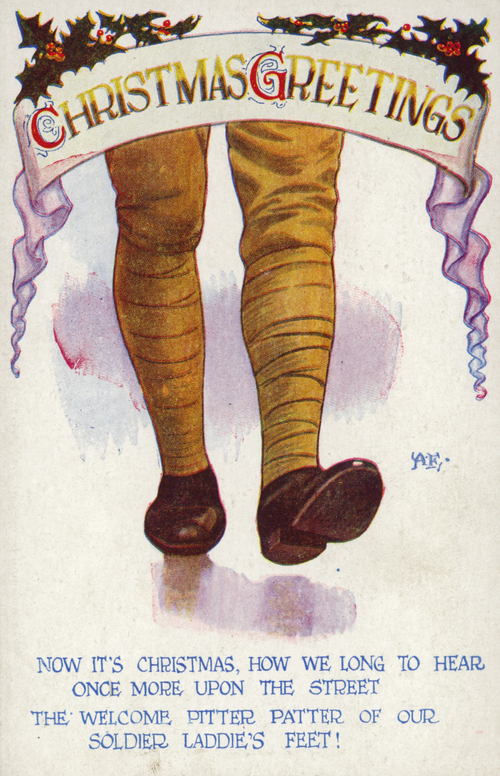
Poignant Christmas messages at the time of World War I
3. RELIGION AND MYTH, WAR AND CHARITY
By the beginning of the 20th century religious imagery was becoming more common, and the reproduction of paintings in museums and galleries became increasingly popular as the quality of colour and detail improved.
World events, meanwhile, prompted specific types of cards, such as the patriotic and humorous ones sent in the time of World War I. Later in the century came a new development, as an increasing number of charities produced their own cards, kick-started by the first UNICEF card in 1949; such cards are a particularly British phenomenon.
Christmas cards have become a means of maintaining cohesion among societies and movements. Political parties, corporate organisations and campaigning groups all use the Christmas card as marketing devices, or even vehicles for protest. Above all, they have become a convenient way of keeping in touch with friends and acquaintances. When we say that someone has ‘dropped off our Christmas card list’, we mean that we no longer want to keep in touch.
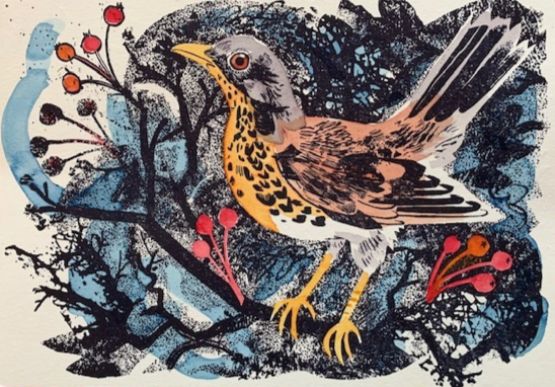
A card by current-day artist Mark Hearld
4. ARTISTS AND THE CHRISTMAS CARD
Contemporary artists have long had their work featured on Christmas cards, one of the earliest being the much-loved Victorian children’s illustrator Kate Greenaway (1846–1901). Charities and commercial organisations have also taken to the concept of artist-designed cards, an example being the publishing house Faber & Faber. In 1950 the illustrator Barnett Freedman (1901–58) designed an arresting three-fold lithograph for them, one of a series that he produced. Another artist to create cards for the firm was Edward Bawden (1903–89). Examples of both their cards can be seen in an exhibition of artists’ Christmas cards at the Pallant House Gallery in Chichester (see details below in my ‘top tips’ section).
The tradition of such artists’ cards continues; for example, Momart (an art handling, transport and storage firm) has been commissioning limited-edition artists’ Christmas cards since 1984. And interestingly, many of the cards made by artists for their private use have become valuable collectors’ items.
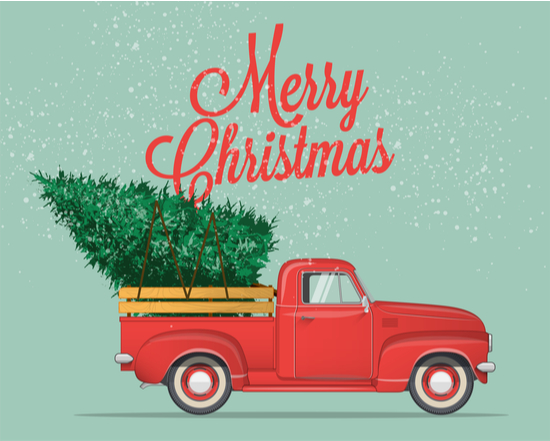
Season's greetings for 2020
5. CHRISTMAS CARDS AS COLLECTABLES
Henry Cole’s first card was the genesis of a multimillion-pound business. According to the V&A Museum, holder of an important collection of Christmas cards, around a billion cards are bought each Christmas in the UK alone. New types of Christmas card have been developed in recent years, such as the folding ‘snow globe’ and cards with miniature light shows and music. But the heyday of commercial Christmas cards has passed, seen off by ecological concerns about one-use cards and envelopes, and the rise in e-cards with their animation and personalised greetings.
More people are making their own cards too, featuring family photos or recycled images from previous cards. In response, some postal services provide inducements to keep traditional hard-copy cards. One of the best promotions was the German post office’s 2004 giveaway of 20 million Christmas-scented stickers.
Collecting Christmas cards has been a serious business from the start: some people go for themes or artists, some for subjects (an animal or bird, for example). Queen Mary’s collection is now in The British Museum, and London’s Slade School of Fine Art has a range of artists’ cards made by former students. The Laura Seddon Greeting Card Collection is now in Manchester Metropolitan University and the John Johnson collection in the Bodleian Libraries, University of Oxford. You can find many smaller collections in local museums and libraries.
Rare, early cards can fetch a great deal at auction. The world record is held by one of Horsley’s 1843 cards, sold for £22,250. That must have been quite the Christmas present for its owner.
Patricia’s Top Tips
See
The exhibition Christmas Greetings by Modern British Artists at Pallant House Gallery, Chichester. Over 100 original cards will be on display, dating from the 1950s to the present day, designed by artists including Edward Bawden, Glenn Brown, Barnett Freedman, Ben Nicholson and Enid Marx. Until 6 January 2021.
Good reads
See Bevis Hillier’s compilation of Victorian cards, Greetings from Christmas Past (Herbert Press Ltd; 1982), and Michelle Higgs’ concise history on the full subject, Christmas Cards: from the 1840s to the 1940s (Shire Publications; 1999).
For an interesting alternative view, see Llew and Pam Smith’s book Glad Tidings of Struggle and Strife: a history of protest Christmas cards (Fonthill; 2012).
Visit
The collections referred to in point 5 at the places (and their websites) mentioned, but a visit to The Postal Museum in London is also illuminating. Find out more here.
Our Expert’s Story
Dr Patricia Andrew studied at the Universities of Nottingham and Edinburgh before working as a curator in Eastbourne, Chelmsford and Durham, then at the Scottish Museums Council. She now lectures for organisations such as the National Galleries of Scotland, and on cruises in Europe and North America. Her published papers and articles cover British artists at home and abroad, and garden history. She is the award-winning author of A Chasm in Time: Scottish War Art and Artists in the Twentieth Century, published by Birlinn Ltd.
Patricia’s lecture topics include The Grand Tour 1650–1850: a cultural phenomenon and its significance; Jean-Étienne Liotard, 1702–1789: the greatest artist you might not know; Ideal landscapes: the history of the English landscape garden, 1750–1830; and, of course, The Christmas card: its story, images and symbols.
IF YOU ENJOYED THIS INSTANT EXPERT FEATURE...
Why not forward this on to a friend who you think would enjoy it too?
Stay in touch with The Arts Society! Head over to The Arts Society Connected to join discussions, read blog posts and watch Lectures at Home – a series of films by Arts Society Accredited Lecturers.
Show me another Instant Expert story
Images (top to bottom): © Shutterstock; Wikipedia; Victorian Christmas card courtesy of Patricia Andrew; World War I Christmas card © Bridgeman Images; Mark Hearld image: courtesy of Pallant House Gallery/on loan from a private collection; © Shutterstock
About the Author
Patricia Andrew
Article Tags
JOIN OUR MAILING LIST
Become an instant expert!
Find out more about the arts by becoming a Supporter of The Arts Society.
For just £20 a year you will receive invitations to exclusive member events and courses, special offers and concessions, our regular newsletter and our beautiful arts magazine, full of news, views, events and artist profiles.
FIND YOUR NEAREST SOCIETY
MORE FEATURES
Ever wanted to write a crime novel? As Britain’s annual crime writing festival opens, we uncover some top leads
It’s just 10 days until the Summer Olympic Games open in Paris. To mark the moment, Simon Inglis reveals how art and design play a key part in this, the world’s most spectacular multi-sport competition



